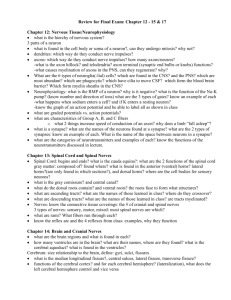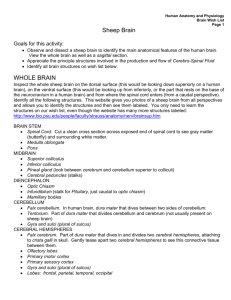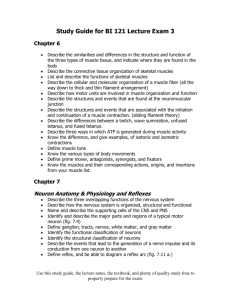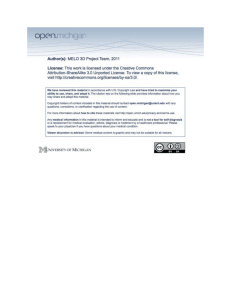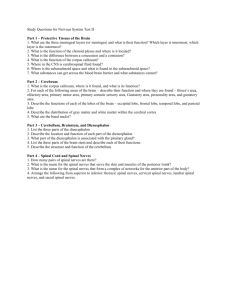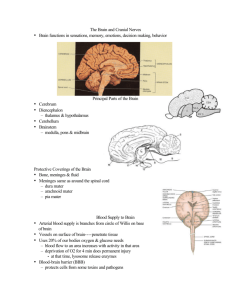Sheep Brain Dissection
advertisement
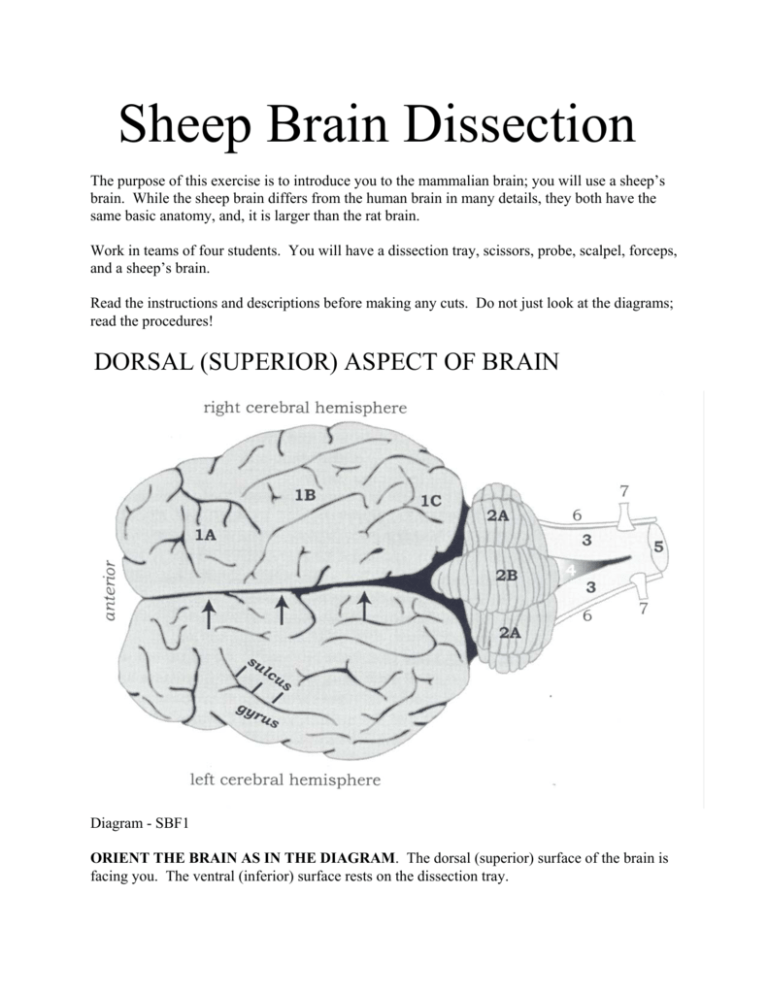
Sheep Brain Dissection The purpose of this exercise is to introduce you to the mammalian brain; you will use a sheep’s brain. While the sheep brain differs from the human brain in many details, they both have the same basic anatomy, and, it is larger than the rat brain. Work in teams of four students. You will have a dissection tray, scissors, probe, scalpel, forceps, and a sheep’s brain. Read the instructions and descriptions before making any cuts. Do not just look at the diagrams; read the procedures! DORSAL (SUPERIOR) ASPECT OF BRAIN Diagram - SBF1 ORIENT THE BRAIN AS IN THE DIAGRAM. The dorsal (superior) surface of the brain is facing you. The ventral (inferior) surface rests on the dissection tray. Observe: The brain is covered with a transparent membr4ane, the arachnoid mater. This is the middle of the three connective tissue membranes or meninges (singular=meninx) that envelope the brain. The outermost covering, the dura mater, is usually left behind when the brain is removed. The innermost covering, the pia mater, covers the surface of the brain beneath the arachnoid. The dark “lines” running over the surface of the brain are blood vessels. IDENTIFY THE CEREBRUM (1) Observe: It is composed of the right and left cerebral hemispheres, separated by the longitudinal cerebral fissure (indicated by arrows). The surface of the cerebrum is thrown into folds called gyri (singular =gyrus), separated by grooves called sulci (singular=sulcus). All are named. For convenience each cerebral hemisphere is subdivided into lobes named for the cranial bones of which they underlie; frontal, parietal, occipital, and temporal. In human brains, precise landmarks are used to define the lobes. For the sheep brain, it is sufficient to have a general idea of the position of the lobes. In a superior view of the brain, only the frontal (!A), parietal (1B), and occipital (1C) lobes are visible. PUT YOUR THUMBS IN THE LONGITUDINAL CEREBRAL FISSURE AND SLIGHTLY SEPARATE THE CEREBRAL HEMISPHERES. Observe: In the floor of the fissure, there is a white band of tissue connecting the two hemispheres. This is the corpus callosum (“hard body”). It is composed of axons that connect the nerve cells of the two hemispheres. IDENTIFY THE CEREBELLUM (2). Observe: The cerebellum (“little brain”) has three major parts: the right and left cerebellar hemispheres (2A) and the median vermis (“worm”) (2B). The surface of the cerebellum is thrown into plate-like folds called folia (singular=folium - a leaf or page). Note: In the sheep, the vermis is quite large compared to the cerebellar hemispheres. In the human, the hemispheres are much larger and the vermis is much smaller. IDENTIFY THE MEDULLA OBLONGATA (3), SPINAL CORD (5), AND FOURTH VENTRICLE (4). Observe: The medulla is continuous posteriorly with the spinal cord. The small triangular space on top of the medulla is part of the fourth ventricle, a diamond shaped cavity that contained CSF (cerebrospinal fluid). The delicate membrane that forms a roof for this part of the ventricle is usually destroyed during brain removal. IDENTIFY CRANIAL NERVES XI, THE ACCESSORY NERVES (6). Observe: These are two small white cords running along the sides of the medulla and upper spinal cord. Note: There are twelve pairs of cranial nerves attached to the brain. Each pair is given a number from one to twelve and is also named. Some authors ue Arabic numbers (1,2,3,...12); others use Roman numerals (I, II, III, ....XII). IDENTIFY ANY SPINAL NERVES (7) ATTACHED TO THE SPINAL CORD. These may be absent in your specimen. It depends upon how short the cord was cut and how roughly the specimen was removed from the body. At best, only the upper one or two pairs will be on your specimen. Note: Thirty-one pairs of spinal nerves are attached to the sides of the spinal cord. CAREFULLY PUSH THE POINT OF A PROBE THROUGH THE ARACHNOID COVERING A CEREBRAL HEMISPHERE UNTIL IT REST BETWEEN THE ARACHNOID AND THE BRAIN SURFACE. Observe: The probe now rests in the subarachnoid space between the arachnoid and the pia mater. In life, the space was filled with cerebrospinal fluid (CSF). Over the gyri the space is narrow. Where the arachnoid bridges over sulci, the space is deeper. Where the arachnoid crosses larger gaps, such and that between the cerebrum and the cerebellum, the space con be quite large. Such large spaces are called cisternae. Note: CSF is produced by structures called choroid plexuses, small masses of ependimal tissue located in the cavities of the brain known as ventricles. The CSF flows through the ventricles, exits through openings in the roof of the fourth ventricle, and enters the subarachnoid space surrounding the brain and spinal cord. WITH FORCEPS, CAREFULLY STRIP AWAY THE ARACHNOID COVERING THE CEREBRAL HEMISPHERES. (IT IS EASIEST TO DO THIS BY GRIPPING THE SMALL BLOOD VESSELS VISIBLE THROUGH THE ARACHNOID AND PULLING,) BE CAREFUL NOT TO DAMAGE THE BRAIN SURFACE. Observe: Beneath the arachnoid, the brain surface is covered with a dull, transparent membrane. This is the inner meninx, the pia mater. Unlike the arachnoid, which bridges over sulci and gaps, the pia closely follows the contours of the brain and is tightly adherent to its surface. Observe: Beneath the pia, the cerebrum is covered with a tan colored material. This is the cerebral cortex, a thin sheet of nerve cells. Note: Though it is tan colored in preserved brains, cortex is grey matter. Grey matter consists mostly of nerve cell bodies and supporting cells know as neuroglial cells. In living or fresh materials, the cytoplasm of the cells gives the material a greyish look. Grey matter that covers a brain surface is called cortex. GENTLY SPREAD THE CEREBRUM AND THE CEREBELLUM APART AS SHOWN IN THE DIAGRAM. Diagram - SBF2 IDENTIFY THE SUPERIOR COLLICULI (1) AND INFERIOR COLLICULI (2). Each colliculus (“little hill”) is caused by a nucleus, a small mass of grey matter. Together, the four colliculi form the corpora quadrigemina (“four twinned bodies”). P Note: Superior colliculus is associated with visual reflexes; Inferior colliculus is associated with auditory reflexes. IDENTIFY THE PINEAL GLAND OR BODY (3). IDENTIFY THE PULVINAR OF THE THALAMUS (4). The thalamus (“a bed”) consists of two bilaterally symmetrical groups of nuclei. In this view, most of the thalamus is hidden by the cerebral hemispheres. Only its posterior end, the pulvinar (“pillow”), is visible as a bulge on either side of the pineal gland and anterior to the superior colliculi. VENTRAL (INFERIOR) ASPECT OF THE BRAIN ORIENT THE BRAIN AS IN THE DIAGRAM. The ventral (inferior or basal surface is facing you. The anterior pole is at the left of the diagram. Diagram - SBF3 STOP! Your specimen may still have a rectangle of dura and the pituitary gland still attached. Cranial nerves II, III, IV, V, and VI may be attached to the dura and the pituitary is attached to the brain by its stalk. You must remove the dura and the pituitary without ripping the nerves from their attachments to the brain. Make all of the following cuts as close to the dura as possible. With scissors carefully cut nerves II and V free from the dura. Carefully lift the posterior end of the dura and cut nerves VI and IV free from the dura. Carefully lift the anterior end of the dura and cut nerves III and the pituitary stalk free from the dura. Remove the rectangle of dura and the pituitary gland. Diagram - SBF4 WITH FORCEPS, CAREFULLY STRIP AWAY THE ARACHNOID COVERING THE INFERIOR SURFACE OF THE BRAIN, BE CAREFUL NOT TO RIP AWAY THE CRANIAL NERVES. IDENTIFY THE INFERIOR SURFACES OF THE FRONTAL (1a) AND TEMPORAL (1b) LOBES OF THE CEREBRAL HEMISPHERES. You observed the frontal, parietal, and occipital lobes on the dorsum of the brain. In this view, only parts of the frontal and temporal lobes are visible. P Note: Frontal lobe is associated with motor functions; temporal lobe is associated with auditory functions. IDENTIFY THE OLFACTORY BULBS (2A), TRACTS (2B), AND STRIAE (2C-D) Observe: Posteriorly, each bulb leads to an olfactory tract (2b). More posteriorly, each tract divides into two flattened bands: a lateral (2c) and a medial (2d) olfactory stria (“stripe”). Posteriorly, each stria fades into the surrounding cerebral cortex. Note: The bulbs, tracts, and striae are much larger in the sheep than they are in the human. P Note: Odor molecules are capture by the olfactory epithelium of the superior nasal cavity where they stimulate special receptors. Receptor processes pass through the numerous small perforations of the cribriform plate of the ethmoid bone. IDENTIFY THE ANTERIOR PERFORATED SUBSTANCE (3). This triangular area of cerebral cortex between the medial and lateral olfactory striae is called “perforated” because it is pierced by small blood vessels that supply many of the deep structures of the brain. They are common sites of strokes or cerebrovascular accidents (CVA’s). IDENTIFY THE OPTIC NERVES (ii), OPTIC CHIASMA (4A) AND OPTIC TRACTS (4B). Observe: The optic nerves and optic tracts meet to form an X-shaped structure, the optic chiasma (“cross”). Laterally, each optic tract disappears under a roughly triangular part of the temporal lobe, the uncus. In the sheep, the uncus forms most of the temporal lobe; in humans, it is much smaller. P Note: The image from each eye passes along the optic nerve. At the chiasma, all of the fibers associated with the right field of view pass to the right and all of those associated with the left field of view pass to the left. IDENTIFY THE TUBER CINEREUM (5). Observe: The tuber cinereum (“ashy bump”) is a small, puffy area just behind the optic chiasma. The stalk of the hypophysis, the infundibulum, attaches to it. You should see a small hole in its center. P Note: The pituitary, or master gland, is attached here and has fibers, axons, passing to the hypothalamus, which exercise control over the neurohypophysis (posterior pituitary). IDENTIFY THE MAMMILLARY BODY (6). The mammillary (“little breast”) body is a bump located just posterior to the tuber cinereum. It is caused by the mammillary nuclei, small masses of grey matter. In the sheep, it looks like a single, large structure. In the human, there are two well-defined, but much smaller, mammillary bodies; these rest upon the floor of the hypothalamus and are part of the limbic system. P Note: The fornix is a tract of white matter that connects the hippocampus with the hypothalamus. Many of the fibers end in the mammillary bodies, which motor nuclei control reflex movement associated with eating, e.g., chewing, licking, and swallowing. IDENTIFY THE CEREBRAL PEDUNCLES (7) AND OCULOMOTOR NERVES (iii). Observe: The cerebral peduncles are two cylindrical, whitish structures on either side of the tuber cinereum and the mammillary body. Anteriorly, they disappear at the optic tracts. Laterally, each is flanked by the uncus of the cerebral hemisphere. The oculomotor nerves (cranial nerves III) are the small white ribbons attached to each peduncle. P Note: They contain ascending fibers headed for the thalamic nuclei and descending voluntary motor fibers from the primary motor cortex. IDENTIFY THE PONS (8), TROCHLEAR NERVES (iv), AND TRIGEMINAL NERVES (v). Observe: The pons resembles an arched “bridge” running across the brain. Posteriorly, it is separated from the medulla (9) by a groove. The trochlear nerves (cranial nerves IV) are white, thread-like structures that run between the anterior edge of the pons and the adjacent parts of the cerebral hemispheres. They actually arise from the dorsal surface of the brain, but wrap around the sides of the cerebral peduncles to the basal surface. The much larger trigeminal nerves (cranial nerves V) arise from the sides of the pons. They may have been cut very short, when your specimen was removed from the skull. However, you should still be able to find where they attached to the pons. P Note: The pons links the cerebellar hemispheres with the mesencephalon, diencephalon, cerebrum, and spinal cord - ascending, descending, and transverse tracts, as well as nuclei for the muscles of the face and respiratory reflexes. IDENTIFY THE CEREBELLUM (10) Observe: Since the cerebellum sits on top of the pons and medulla and this is an inferior view of the brain, only a small part of each cerebellar hemisphere is visible. Look in the area between the cerebellar hemisphere and the side of the pons. You should see a band of tissue running from the pons into the cerebellum. This is the middle cerebellar peduncles or brachium pontis (“arm of the bridge”). Do not confuse it with the cerebral peduncle. It contains bundles of axons connecting nerve cells in the two cerebellar hemispheres and axons connecting nerve cells in nuclei in the pons with the cerebellum. P Note: The cerebellum contains large highly branched Purkinje cells, which have numerous dendrites fanning out into the gray matter. This should be considered in regards to our conversations related to learning, intelligence, networking and connections. The cerebellum is an automatic process center for 1) Adjusting the postural muscles of the body maintaining balance and equilibrium and 2) programming and fine tuning voluntary and involuntary movements by storing memories of learned movement patterns. Now, consider the importance of the cerebellum in learning motor reflex skills and associated movements with the anatomical distribution and connections of the Purkinje cells. IDENTIFY THE MEDULLA OBLONGATA (9a) AND SPINAL CORD (11) Observe: Anteriorly, a groove separates the medulla from the pons. Posteriorly, the medulla tapers into the spinal cord (10). In the midline, a slight groove runs the length of the medulla, dividing it in half. On either side of the groove, there is a thin slightly raised band, the pyramid (9c) . The reticular system, which consist of a loosely organized network of neurons the extend through out the brain stem, from the pons down through the medulla with reticulospinal tracts extending down the spinal cord. It receives input from almost every ascending and descending pathway and has extensive interconnections with the cerebrum, the cerebellum, and brain stem nuclei. P Note: The reticular formation is responsible for astronomic functions, e.g., cardiovascular and respiratory rhythmicity centers. Observe: About halfway along its length, the groove is obliterated by a series of very faint criscrossing lines. This is the decussation of the pyramids. P Note: Descending motor fibers cross over to the opposite side of the body at this juncture. Recall that the right side of the brain controls the left side of the body and vice versa. Observe: On either side of the medulla, there is an ovoid swelling, the olive (9b), caused by a nucleus. P Note: The olive nucleus relays information from the spinal cord, cerebral cortex and brain stem to the cerebellar cortex. IDENTIFY CRANIAL NERVES VI - XII STOP! You may have difficulty identifying the above cranial nerves. On some specimens, they will have been damaged when the brain was removed. Do the best you can and if you cannot find a particular nerve, at least know its general location on the brain. Observe: All of these nerves arise from the medulla. The abducens nerves (cranial nerves VI) are thread-like and arise from the anterior surface of the medulla near the groove separating it from the pons. The facial and vestibulocochlear or auditory nerves (cranial nerves VII and VIII) are located together near the junction of the pons, medulla, and cerebellum. (You may see three nerves here. The larger ones and one very delicate one. The facial nerve has two roots: one large, one small - sensory and motor.) The glossopharyngeal and vagus nerves (cranial nerves IX and X) arise from the medulla just posterior to the facial and auditory nerves. The hypoglossal nerves (cranial nerves XII) arise from the medulla lateral to the pyramids and medial to the olives. The accessory nerve (cranial nerves XI) are thread-like and run along the sides of the medulla. They are separated from the hypoglossal nerves by the olives. MEDIAN SECTION OF THE BRAIN LAY THE BRAIN IN THE DISSECTING PAN WITH ITS SUPERIOR SURFACE UP. WITH THE SCALPEL, SLICE DOWN THROUGH THE LONGITUDINAL CEREBRAL FISSURE AND CUT THE CEREBRUM IN HALF. CONTINUE THE CUT POSTERIORLY THROUGH THE CORPORA QUADRIGEMINA, CEREBELLUM, PONS, MEDULLA, AND SPINAL CORD. DO NOT SAW. MAKE A CLEAN SLICE. STAY IN THE MEDIAN PLANE. Examine the median surfaces of the two halves of the brain. If you stayed in the median plane, they should look pretty much like the diagram below. Diagram - SBF5 IDENTIFY THE SPINAL CORD (21) AND THE CENTRAL CANAL (22). Note: The central canal is a small tubular channel running through the spinal cord. Anteriorly, it is continuous with the fourth ventricle. It contains CSF. P Note: Cerebral spinal fluid (CSF) flows down the central canal of the spine to the subarachnoid space at the base of the spinal cord. IDENTIFY THE VERMIS OF THE CEREBELLUM (20). Observe: Since you sliced down the median plane, the scalpel cut through the vermis. It consists of a blanching core of white matter covered with a this layer of gray matter, the cerebellar cortex. Each branch of white matter forms the core of a cerebellar fold or folium. The pattern of branching white matter capped with cortex is sometimes called the arbor vitae, the “tree of life.” The central mass of white matter contains nuclei, but they are usually not visible. Note: The cerebellum is connected to the rest of the brain by three pairs of cerebellar peduncles: anterior, middle, and posterior. Axons running through the peduncles connect (1) the cerebellum with the cerebral hemispheres, (2) the cerebellum with the spinal cord, and (3) the two cerebellar hemispheres with each other. P Note: These connections put the cerebellum in a position to monitor motor information sent from the brain to the spinal cord; compare it to sensory information sent from the spinal cord to the brain; and make any necessary adjustments. IDENTIFY THE MEDULLA (18) AND THE PONS (17). Observe: The cut surfaces of the medulla and pons do not usually show much detail. They look more or less white, because of all the projection tracts running through them. If you look very closely, you may see some faint tan colored areas scatted through the white matter. These are nuclei. P Note: Between the pons and the cerebellum is a space, the Fourth Ventricle; on the posterior wall is the choroid plexus, which produces CSF. Above and below this are the lateral and median apertures, which allow for the passage of CSF to the subarachnoid space of the meninges surrounding the brain. IDENTIFY THE CORPORA QUADRIGEMINA (16), THE CEREBRAL PEDUNCLES (14), THE CEREBRAL AQUEDUCT (15), AND THE POSTERIOR COMMISSURE (7). Observe: A narrow channel, the cerebral aqueduct, runs through the midbrain. It carries CSF from the third ventricle (see below) to the fourth ventricle. The aqueduct is used to divide the midbrain into two parts: the tectum (“roof”), above the aqueduct; and the tegmentum (“floor”), below the aqueduct. The corpora quadrigemina form most of the tectum.. The cerebral peduncle are located in the ventral part of the tegmentum.. Above the peduncles, the tegmentum consists of nerve tracts and nuclei. However, there is usually little visible detail. The posterior commissure is located just anterior to the superior colliculi. It connects the nerve cells in the nuclei of the two superior colliculi. IDENTIFY THE PINEAL GLAND (9). IDENTIFY THE THALAMUS (8A) AND MASSA INTERMEDIA (8B). Observe: The thalamus (“bed”) forms the upper walls of the diencephalon. It consists of two sets of nuclei, one on either side of the brain. Each set is a cluster of several nuclei. Structurally, and apparently functionally, the two sets of nuclei are identical. In a median sectioned brain, you are looking at only the smooth, ovoid, medial aspect of either half of the thalamus. Laterally, each half of the thalamus extends quite a ways under the cerebral hemisphere on its side. In some ways, it resembles a bed or couch upon which the cerebral hemisphere “rests”. In most specimens a band of fibers connects the two sets of thalamic nuclei across the midline. This is called the massa intermedia or interthalamic adhesion. If it was present, you cut it when you sectioned your specimen. IDENTIFY THE HYPOTHALAMUS (10) Observe: The hypothalamus forms the lower walls of the diencephalon. It is roughly triangular in shape and is usually separated from the thalamus above by a shallow, curved groove. Like the thalamus, the hypothalamus consists of right and left sets of nuclei, but it also contains some median, unpaired nuclei. Each half contains about twelve nuclei. As with the thalamus, in a median section, all that you can see are the medial aspects of the two halves of the hypothalamus. IDENTIFY THE OPTIC CHIASMA (11), TUBER CINEREUM (12), AND MAMMILLARY BODY (13). Observe: you identified these three structures in you examination of the inferior aspect of the brain. They sit in the floor of the diencephalon. IDENTIFY THE THIRD VENTRICLE. Observe: The third ventricle is a narrow, slit-like space bounded by the two halves of the thalamus above and the hypothalamus below. It may be difficult to recognize because you opened it when you sliced the brain. Posteriorly, it connected with the cerebral aqueduct. Anterolaterally, it connected with the lateral ventricles of the cerebral hemispheres (see below). Its roof contained a choroid plexus. (It may be visible in your specimen as a greyish-pink, soft mass.) In life, the third ventricle contained CSF. Some of the CSF was produced by its own choroid plexus; some flowed in from the lateral ventricles. IDENTIFY THE MEDIAL SURFACES OF THE FRONTAL (1A), PARIETAL (1B), AND OCCIPITAL (1C) LOBES OF THE CEREBRAL HEMISPHERE. IDENTIFY THE OLFACTORY BULB (5A) AND TRACT (5B). IDENTIFY THE CORPUS CALLOSUM (2), SEPTUM PELLUCIDUM (4), AND FORNIX (3). Observe: In median section, the corpus callosum is a long white, narrow band running along the medial aspect of each cerebral hemisphere. Its anterior end (2a) is called the genu (“bend”); its middle part (2b), the body; and its posterior end (2c), the splenium (“bandage”). The fornix is a white band of tissue that angles down and forward from the posterior end of the corpus callosum. On at least one of your brain halves, there should be a sheet of tissue filling the gap between the fornix and corpus callosum. This is the septum pellucidum (“transparent wall”). The septum pellucidum is actually composed of two sheets of tissue, separated by a space. STOP! Look at the two halves of your brain. Is there a septum pellucidum on both halves? If so, then you sliced down through the space. If there is a septum on one half and not on the other, then your cut was parasagittal. If necessary, carefully cut away and remove the septum pellucidum to find the space between. IDENTIFY THE LATERAL VENTRICLE AND THE CAUDATE NUCLEUS. Removal of the septum pellucidum exposes a large cavity. The lateral ventricle, in each cerebral hemisphere. Look inside the lateral ventricle. In the floor there is a rounded mass, the caudate (“tailed”) nucleus. Anteriorly, it is large; posteriorly, it is tapering. It is actually C-shaped, but you can see only the fatter, upper part of the C. The caudate is one of a cluster of nuclei located in each cerebral hemisphere and referred to as the basal nuclei. At the angled junction of the roof and the lateral wall of each ventricle, you may see an elongated greyish mass of tissue. This is a choroid plexus. IDENTIFY THE ANTERIOR COMMISSURE. Observe: This small, round band of commissural fibers is located at the anterior end of the fornix. (They are not connected.) It was cut when you sectioned the brain. CLEAN-UP Return the scalpels to the container. Wipe the forceps, scissors, probe, and dissection tray clean with paper towels and return them to the cart. Clean your work area with wetted paper towels. Discard all animal waste, gloves, and paper towels in the appropriately marked receptacles. Wash your hands. Anatomy 14, M. J. Malachowski, Ph.D. Modified from: M.. J.. Guthrie, Ph.D. CCSF Anatomy Laboratory Manual Copyright 2005 - This material may not be used except with the expressed permission of the authors.

